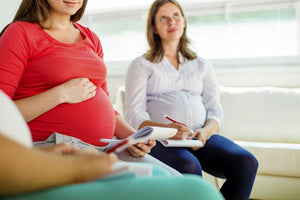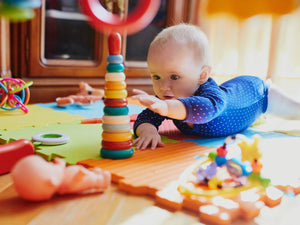The most important function of the forceps is traction, to be able to pull the baby out. However forceps may also be invaluable for rotation especially in occiput transverse (baby faces mum’s hip) and occiput posterior (baby faces mums abdomen) positions. The force produced by forceps on a baby’s skull is a complex function of both traction and compression by the forceps as well as friction produced by maternal tissues. (William Obstetrics, 2010)
Adverse Effects of Forceps
For all the good that forceps do, there is the flip side of pulling too hard including; bruising, causing a “cone head” shape or a sprain neck. The strength of the forceps pulling on a delicate head and neck may also have implications later in life. Forceps place enormous stress on the baby’s head and neck, which in turn can affect the range of motion in the cervical spine, which can affect breastfeeding and comfort of the baby. It can also cause TMJ (jaw) dysfunction, which impacts on “suck-swallow” reflex. It may also lead to torticollis (wry neck) and/or plagiocephaly (flattened head). Plagiocephaly can affect development and learning later in life. (RI Miller at al, 2000)
The most common area for the forceps to be placed is on the wider part of the skull, which is the parietal region. However, the position of the baby’s head will depend on whether the forceps blades are placed on the temporal, frontal and/or zygomatic arch.
I am not suggesting to never use forceps, I believe they are too invaluable in times of need. I do believe that for stressful labours where forceps are used, we should check these babies post-delivery to prevent developmental and breastfeeding issues.
Potential Complications from a Forceps Delivery
There are many things that midwives, OB-GYNs, Paediatricians, GPs and Maternal health nurses can look out for when assessing new babies including:
- Is Mum breastfeeding?
- Was it difficult for Mum to establish breastfeeding?
- Did baby have difficulty with attaching?
- Does baby prefer one breast?
- Does baby lean his/her head to one side?
- Is baby having difficulty sleeping?
- Does baby hate tummy time?
- Does baby have excess colic, wind, reflux?
- Does baby have flattening of one side of the back of the head? Or an odd shaped head?
- Is baby having difficulty responding to auditory stimulus due to the inability to turn his head?
- Is baby having difficulty with six positions of gaze?
- Is baby experiencing delayed motor development?
Plagiocephaly (flat head syndrome)
Plagiocephaly can result for a number of reasons – abnormalities in brain shape, premature fusion of a single coronal or lamdoidal suture(the sutures allow the “squashing” of the skull during birth) and lastly, prenatal or postnatal factors. (Miller, 2000, Pediatrics)
Deformational plagiocephaly due to external forces is the most common and may occur prenatally when the baby’s head rests for a prolonged period on a hard surface such as mum’s pelvis, or against the limb of a sibling in a multiple birth.
When the plagiocephaly occurs postpartum, it can be due to forceps or suction, torticollis (wry neck), forced sleeping position, vertebral anomalies or neurologic impairment (Miller, 2000, Pediatrics). Due to the skull being very soft, the bones are very easily affected by pressure. Other causes include weak infant muscles, birth trauma and in-uterine constraint; therefore they readily turn to one side, which then causes the skull to become flat.
It is important to note, that plagiocephaly is not merely a cosmetic issue, as it may indicate restrictions between the skull and the soft layers that cover the brain and spinal cord. A healthy brain requires good movement of the skull and spine, when this is impaired, brain and nerve functions may also be impaired. Studies are now showing that it can impact on motor development, learning and behaviour. Miller et al state, “infants with deformational plagiocephaly comprise a high risk group for developmental difficulties presenting as subtle problems of cerebral function during the school age years. These children received special help in primary school including special education assistance, physical therapy, occupational therapy and speech therapy”.
Plagiocephaly is becoming more and more prominent. Ensuring that these children get the help they need during infancy prevents these issues later in life.
If you have any concerns about your baby’s health or development, talk to your health care professional.
Our Products
-

01. Guide to a Healthy Pregnancy
$55 -

02. Positive Birthing Course
$55 -

03. Infant Feeding Guide
$55 -

04. Baby Sleep Guide - First 12 Months
$55 -

05. Toddler Parenting Course 1 - 3 Years
$55
-
 When to Start Antenatal Classes?
When to Start Antenatal Classes?
Becoming a parent is an incredible milestone, but it comes with a host of changes that can be daunting, especially for first time parents. Antenatal classes are all about offering expectant parents the education they need to make informed decisions, look after their bodies and care for their newborn babies. While you probably already have a long list of things you need to accomplish during your pregnancy, it’s a good idea to make time to attend antenatal classes.
-
 Development Milestones 4-8 Months
Development Milestones 4-8 Months
As they reach the middle of their first year, you'll start to see bigger leaps in their growth and ability!
In this article, we’re going to discuss your baby’s developmental milestones between 4-8 months, and what you can expect along the way.





 When to Start Antenatal Classes?
When to Start Antenatal Classes?
 Development Milestones 4-8 Months
Development Milestones 4-8 Months








